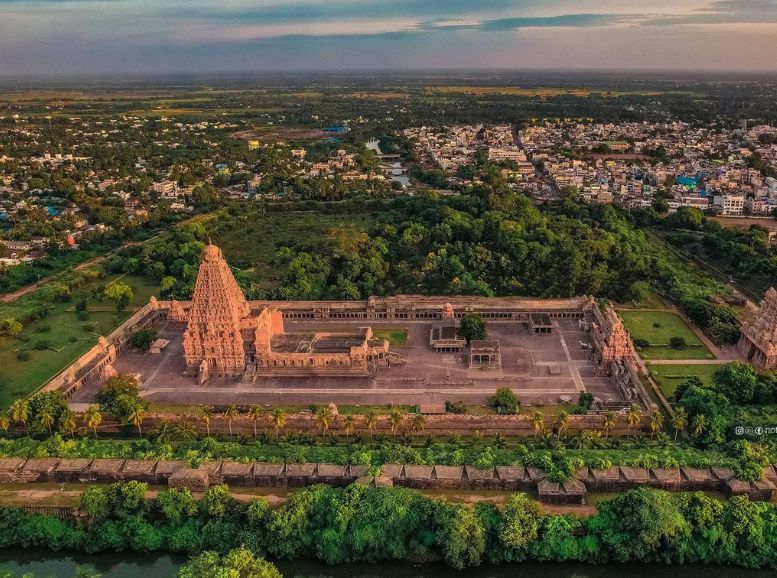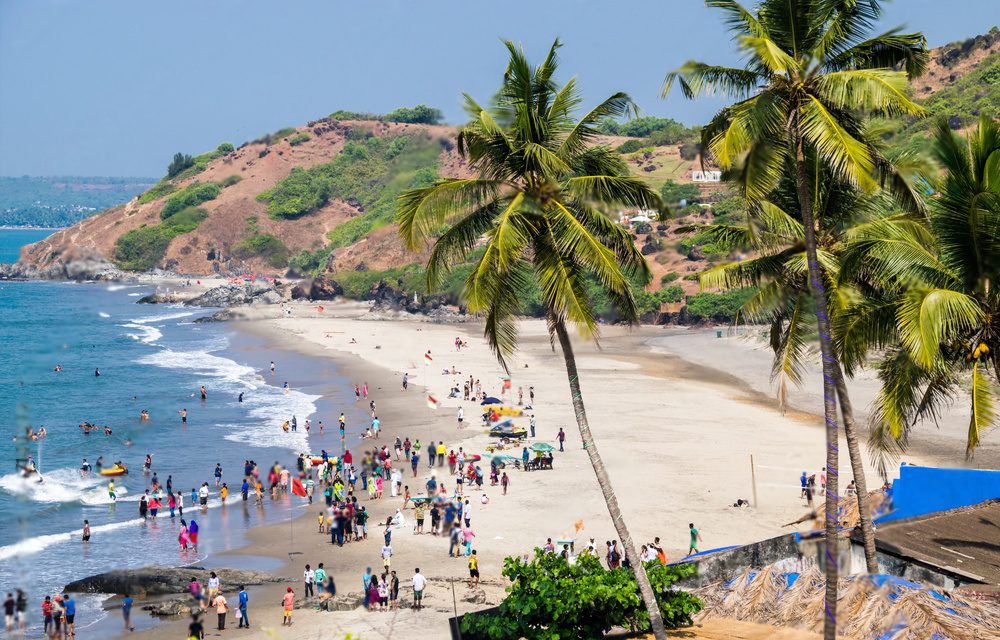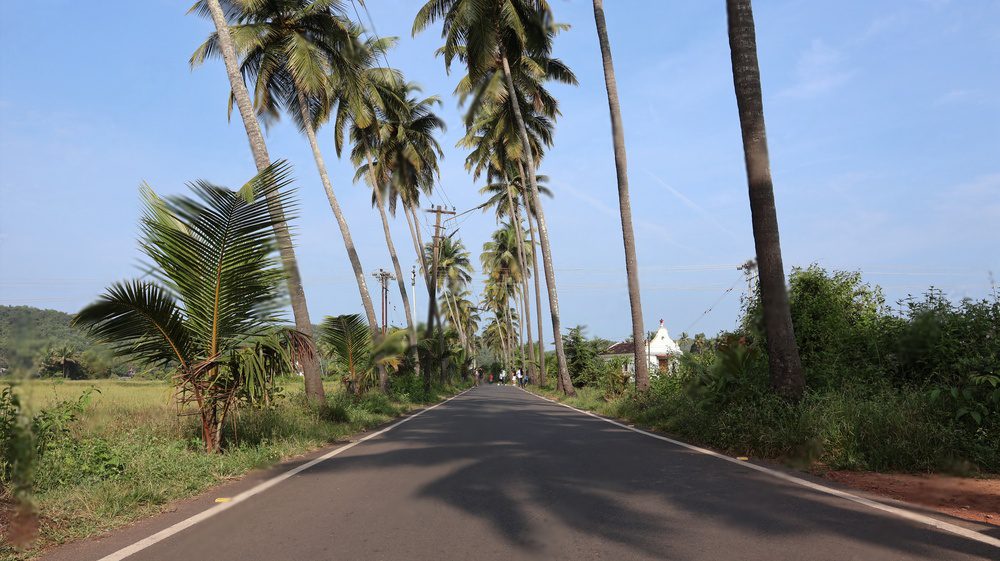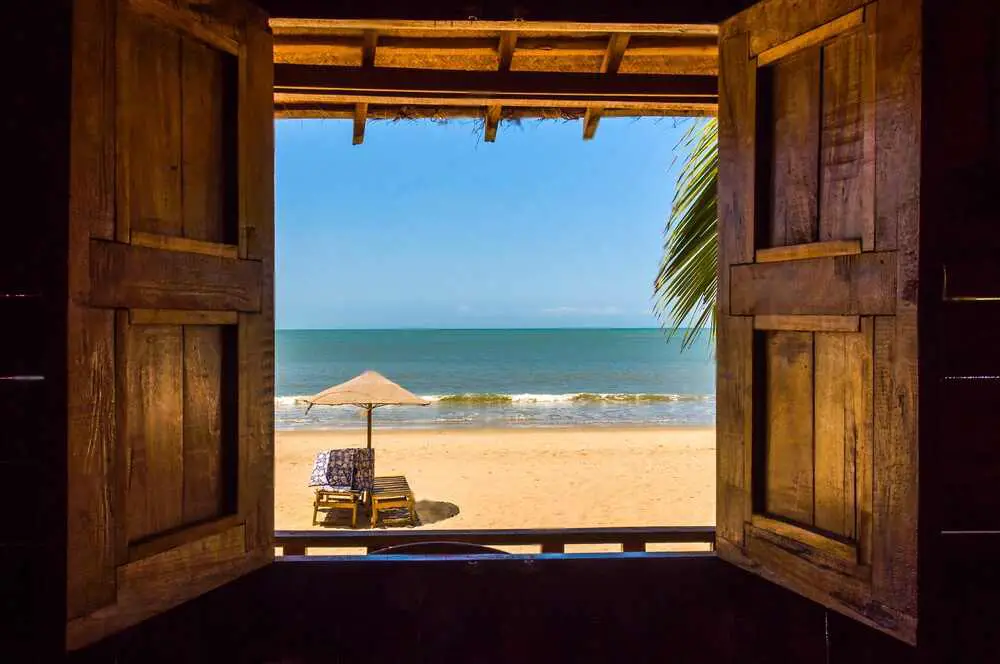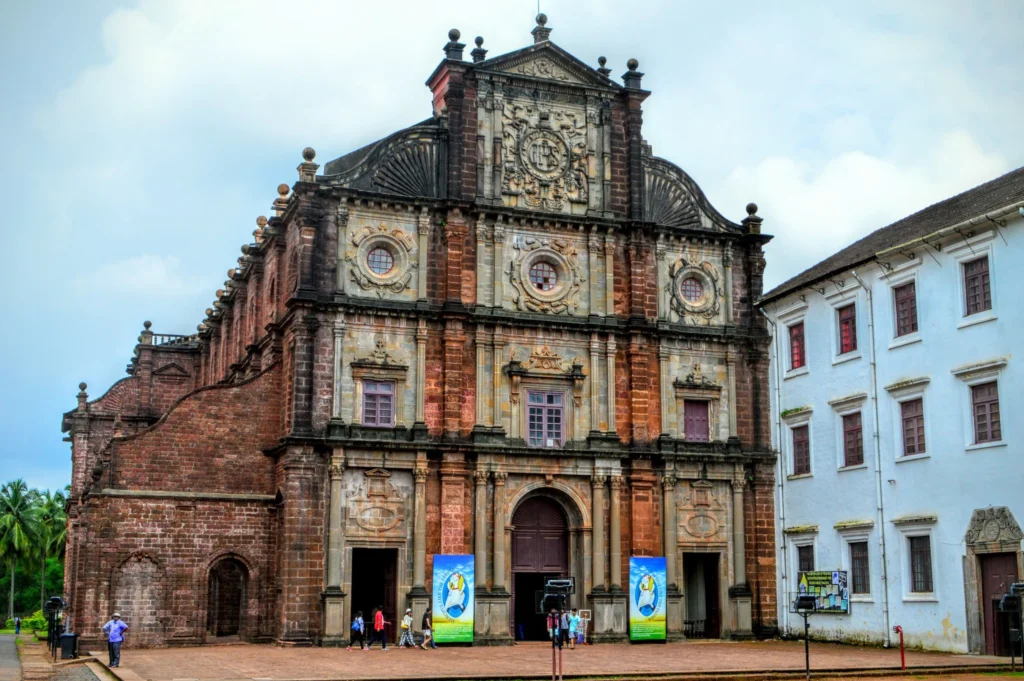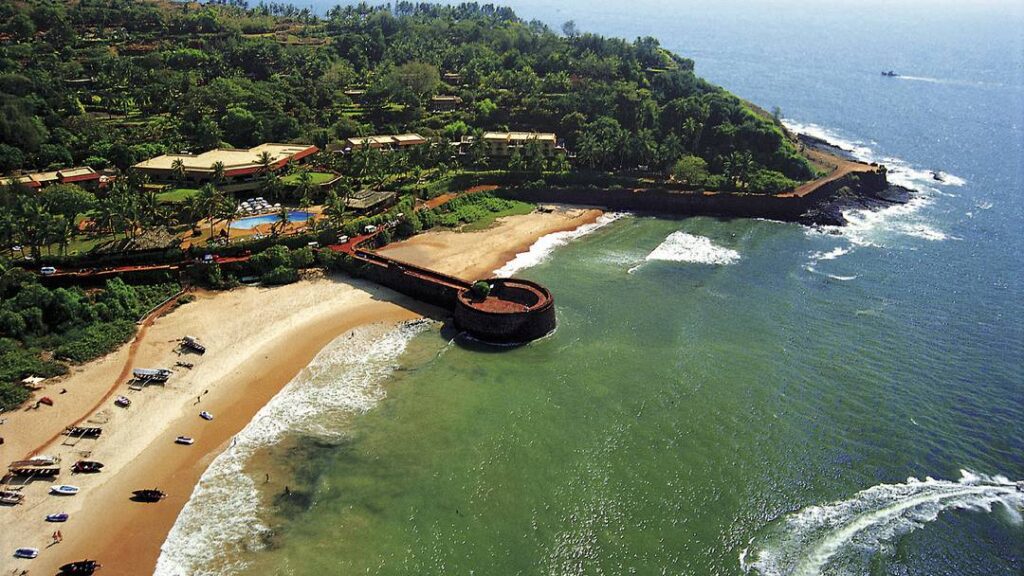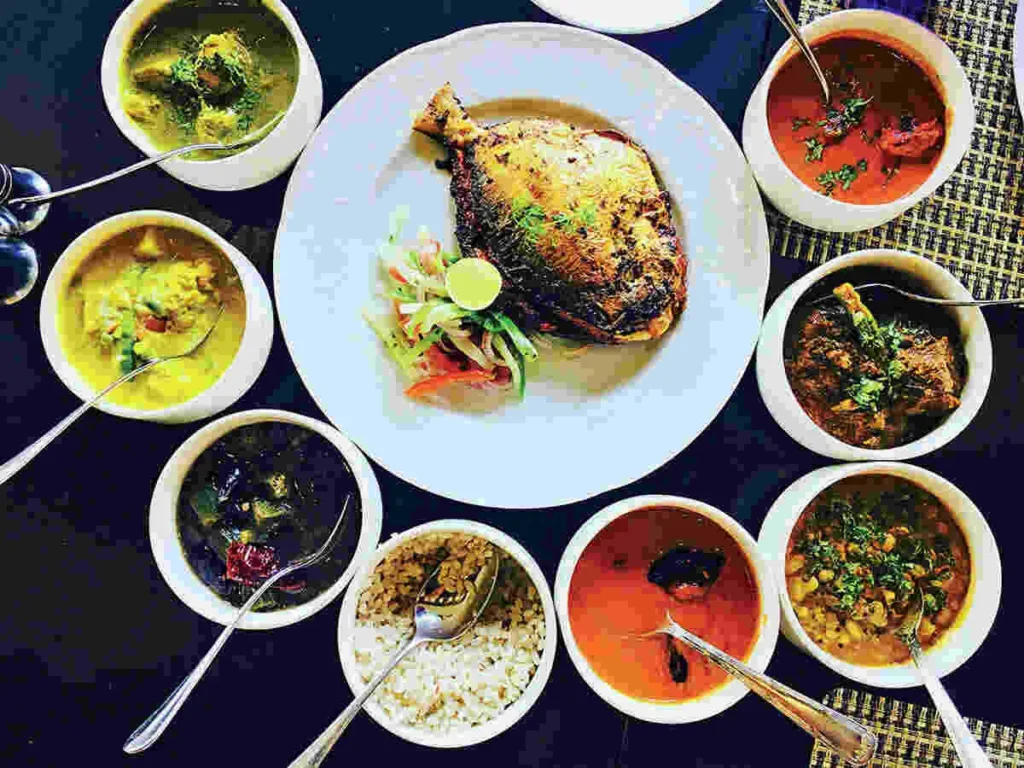Thriving amidst the fertile lands of the Kaveri Delta, Thanjavur boasts a rich history brimming with art and tradition. Earning titles like “Rice Bowl of Tamil Nadu” and “Cultural Capital of the State,” Thanjavur is famed for its awe-inspiring temples, captivating art forms, and a deep cultural heritage.
Embark on a captivating adventure through Thanjavur’s timeless beauty. We’ll delve into its ancient temples, explore the vibrant cultural tapestry, and uncover the legacy of its glorious past. From the majestic Brihadeeswarar Temple to the intricate paintings unique to Thanjavur, this city offers a window into the heart of Tamil Nadu’s heritage.
How to reach:
Air: Tiruchirapalli International Airport (TRZ), roughly 60 kilometers away, is your closest air gateway to Thanjavur. Taxis and buses are readily available at the airport to whisk you to the city.
Train: Thanjavur boasts excellent rail connectivity to major Indian cities. Thanjavur Junction, the city’s main railway station, welcomes trains from Chennai, Coimbatore, Madurai, and other key destinations.
Road: Thanjavur enjoys good road links to nearby towns and cities. National Highway 67 cuts through Thanjavur, connecting it to Trichy, Madurai, and Coimbatore. State-run buses and private taxis from neighboring cities can also bring you to Thanjavur.
Travel Time Estimates:
- Chennai (340 km):
- Road: Approximately 6-7 hours
- Train: Travel time varies between 6-8 hours depending on the train.
- Bangalore (400 km):
- Road: Journey takes around 7-8 hours.
- Train: No direct trains. Take a train to Trichy and then travel by road to Thanjavur.
- Madurai (175 km):
- Road: Approximately 3-4 hours
- Train: Travel time is around 3-4 hours with several trains connecting the cities.
Best time to visit:
Summer (March-May):
Thanjavur heats up in summer, with temperatures climbing between 25°C and a scorching 40°C. The intense heat can make exploring the city and outdoor activities less enjoyable. If a summer visit is unavoidable, pack sunscreen, hats, and sunglasses for sun protection.
Monsoon (June-October):
The monsoon brings moderate to heavy rain. While offering a welcome break from the summer heat, the downpours can disrupt sightseeing and outdoor adventures. Consider other times of year for optimal sightseeing experiences.
Festivals:
To immerse yourself in Thanjavur’s vibrant culture, plan your trip around a festival. The Brihadeeswarar Temple Car Festival in April-May and the Natyanjali Dance Festival in February are renowned events that draw visitors worldwide.
Attractions:
Brihadeeswarar Temple:
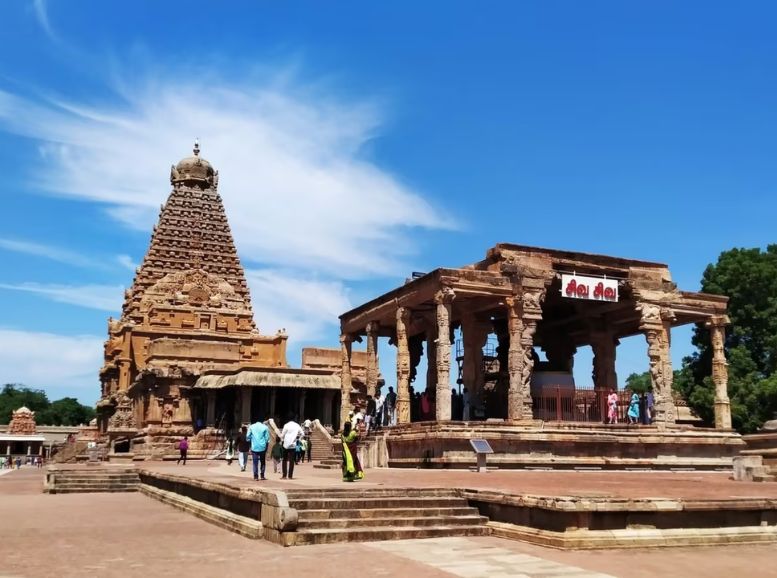

The Brihadeeswarar Temple, also known as the Big Temple, embodies the architectural genius of the Chola dynasty. This UNESCO World Heritage Site, erected in the 11th century by King Rajaraja I, stands tall as one of India’s most prominent temples. Dedicated to Lord Shiva, the temple boasts a towering 216-foot vimana (spire) capped by a colossal, 80-ton monolithic cupola. Exquisite carvings, magnificent architecture, and the awe-inspiring, massive Nandi (bull) statue guarding the entrance leave visitors breathless. More than just a place of worship, the Brihadeeswarar Temple is a living testament to the architectural and engineering marvels of ancient India.
Thanjavur Palace:
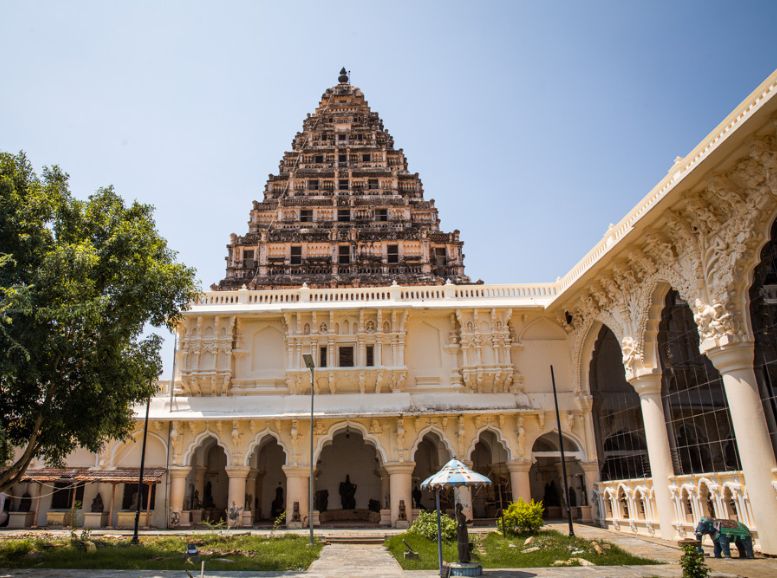

Palace, sometimes referred to as the Maratha Palace, is a sprawling complex that whispers tales of the city’s rich history. Constructed by both Nayak and Maratha rulers, the palace reflects a unique blend of architectural styles. Within the complex, you’ll find the Royal Palace Museum, a treasure trove of artifacts, weaponry, sculptures, and fascinating remnants of the Maratha dynasty’s reign. Other architectural gems include the Durbar Hall, meant for royal audiences, the intricately designed Sarjah Mahal, and a towering Bell Tower. A walk through Thanjavur Palace is a journey through time, offering a glimpse into the lives of royalty and the enduring cultural heritage of the region.
Thanjavur Art Gallery:
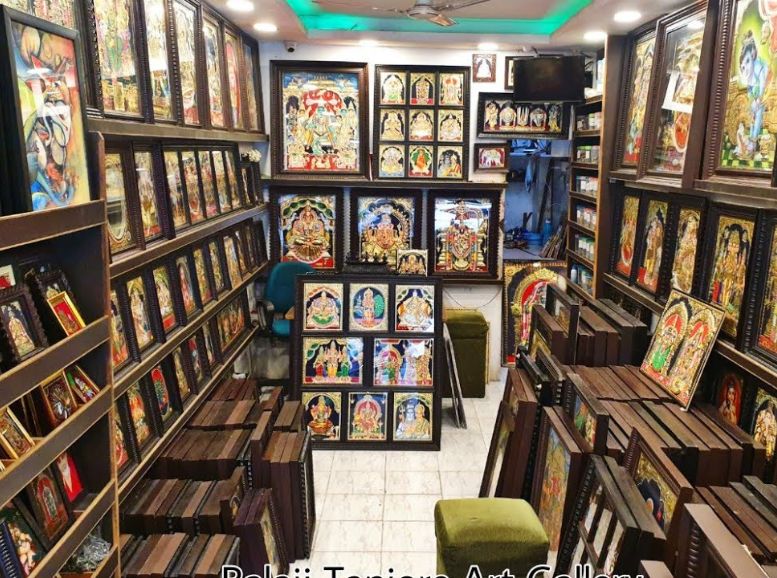

Nestled within the Palace complex lies a haven for art enthusiasts – the Thanjavur Art Gallery. This treasure trove boasts a remarkable collection spanning centuries, showcasing the artistic legacy of Tamil Nadu. Among the gallery’s gems are Tanjore paintings, renowned for their vibrant colors, meticulous details, and even the incorporation of precious stones. Bronze sculptures depicting deities and mythological figures from Hindu tradition offer another window into the region’s artistic heritage. Whether you’re an art aficionado or simply curious about Tamil Nadu’s cultural tapestry, the Thanjavur Art Gallery is a must-visit.
Gangaikonda Cholapuram:
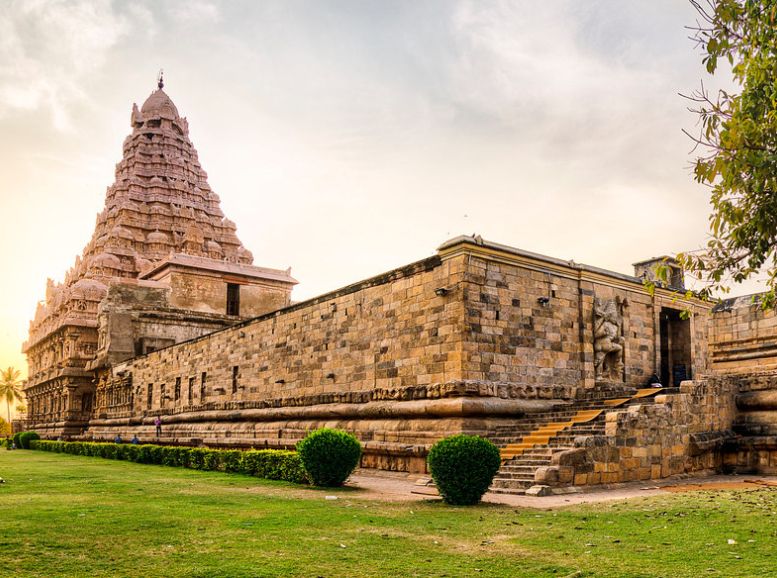

Roughly 70 kilometers from Thanjavur lies Gangaikonda Cholapuram, an ancient temple complex whispering tales of the Chola dynasty. Built in the 11th century by King Rajendra I, the complex is dedicated to Lord Shiva and stuns visitors with its architectural mastery. Intricate carvings, magnificent sculptures, and towering gopurams (temple gateways) adorned with detailed stories in stone captivate the eye. A highlight? The colossal Nandi statue, a powerful symbol guarding the entrance. Gangaikonda Cholapuram stands as a testament to the artistic and architectural genius of the Chola era, making it a must-see for anyone fascinated by history and architecture.
Schwartz Church:
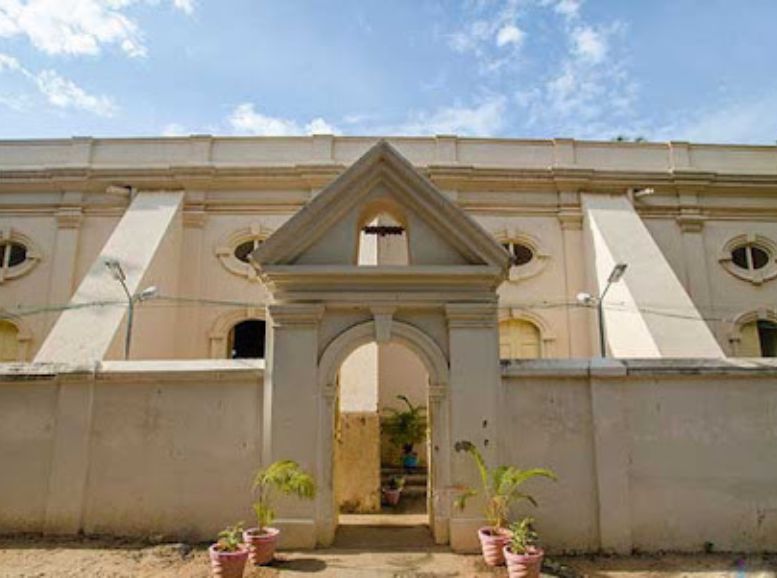

Thanjavur’s rich tapestry extends to religious sites as well. Schwartz Church, sometimes called the New Jerusalem Church, is one of the city’s oldest Christian landmarks. Built in the 18th century, the church honors Reverend Christian Friedrich Schwartz, a German missionary who left a lasting impact on Thanjavur. The architecture itself is a fascinating fusion of European and Indian styles. Whitewashed walls and arched windows create a sense of serenity, while a prominent bell tower adds a European touch. Beyond its religious significance, Schwartz Church stands as a symbol of respect between cultures and a popular destination for those exploring Thanjavur’s diverse heritage.
Sangeetha Mahal:
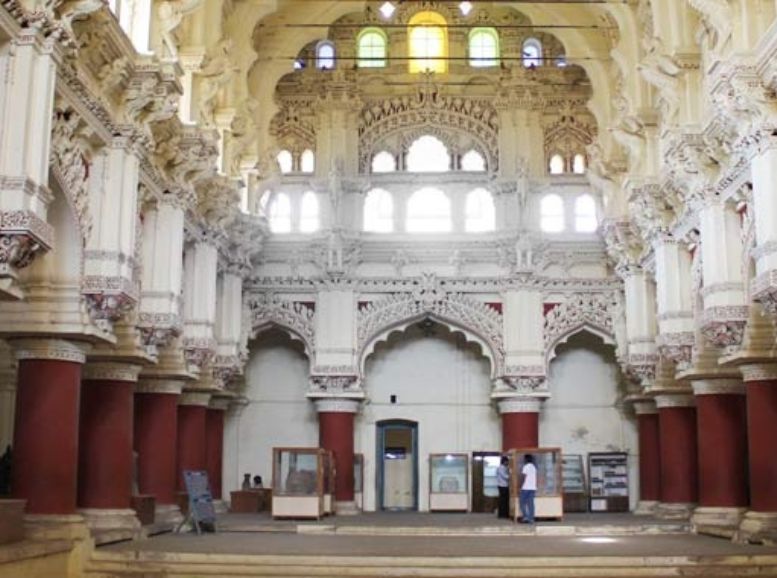

Step inside the Thanjavur Palace complex and discover Sangeetha Mahal, a unique auditorium renowned for its exceptional acoustics. Built by Maratha king Serfoji II, this hall once resonated with the melodies of royal-sponsored musical performances, cultural events, and dance recitals. The true marvel of Sangeetha Mahal lies in its architecture, meticulously crafted to amplify and balance sound. Intricate carvings, decorative pillars, and a regal balcony elevate the space beyond a simple performance hall. Today, Sangeetha Mahal continues its artistic legacy, hosting cultural events and music concerts that keep Thanjavur’s rich cultural heritage alive.
Thiruvaiyaru:
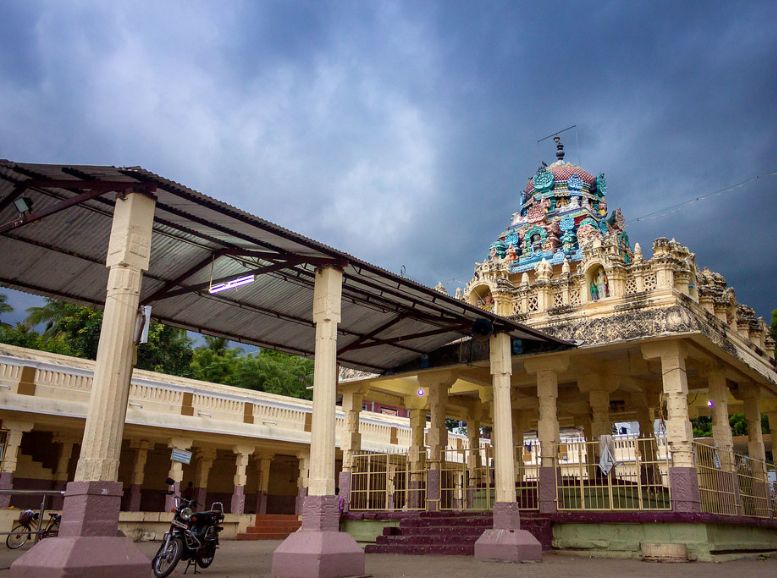

Just outside Thanjavur lies Thiruvaiyaru, a small town humming with the rich tradition of Carnatic music. This town holds special significance for devotees of Saint Thyagaraja, a towering figure in Carnatic music composition. Believed to be his birthplace, Thiruvaiyaru houses the Thyagaraja Temple, where the saint is said to have composed many of his acclaimed works.
Each year, Thiruvaiyaru comes alive with the melodies of the Thyagaraja Aradhana, a week-long music festival held in honor of the saint. This grand celebration draws thousands of musicians and music enthusiasts from across India. They gather to pay homage to Saint Thyagaraja and celebrate the enduring legacy of Carnatic music.
Saraswathi Mahal Library:
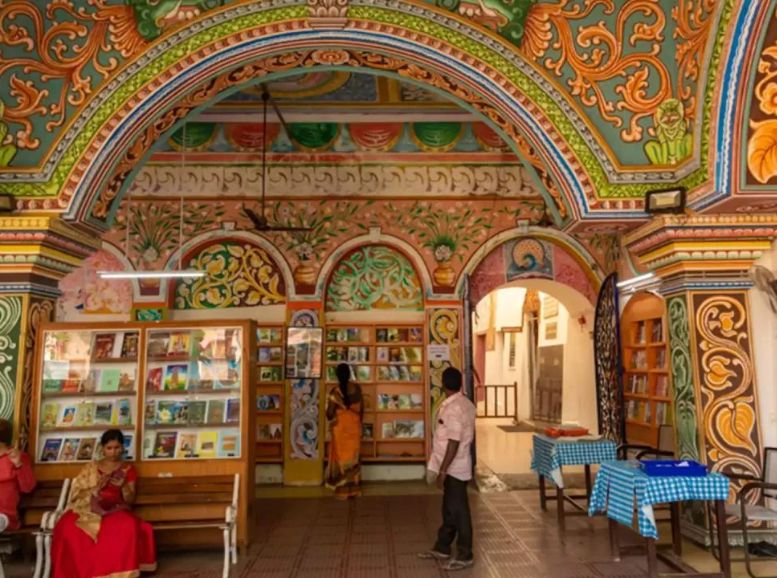

Nestled within the Thanjavur Palace complex lies a treasure trove of knowledge – the Saraswathi Mahal Library, one of Asia’s oldest libraries. Founded in the 16th century by the Nayak kings, the library boasts a vast collection that transcends time. Ancient palm-leaf manuscripts, rare books, historical documents, and artifacts whisper secrets of the past. The collection encompasses a remarkable breadth of subjects, from literature and music to dance, medicine, astrology, and philosophy. More than just a repository, Saraswathi Mahal Library is a sanctuary of knowledge, a valuable resource for researchers, scholars, and anyone curious about Tamil Nadu’s rich cultural heritage.
Local Experiences:
Become a Tanjore Artist: Immerse yourself in a vibrant art form by participating in a Tanjore painting workshop. Learn from local artisans and create your own unique masterpiece to take home.
Savor Local Flavors: Embark on a culinary adventure with a cooking class hosted by a welcoming local family. Learn to prepare delectable Tamil Nadu dishes like dosa, idli, sambar, and rasam using fresh, local ingredients. Enjoy a delicious meal with your hosts and gain insights into the region’s rich culinary heritage.
Unravel the Silk Legacy: Witness the captivating art of silk weaving at a local Thanjavur unit. Watch skilled artisans create stunning silk sarees using time-honored techniques. Find the perfect souvenir – an exquisite silk saree or other handwoven textiles.
A Cultural Extravaganza: Immerse yourself in Thanjavur’s vibrant tapestry with a traditional music or dance performance. Be captivated by the artistry of talented performers, whether it’s a classical Carnatic music concert or a mesmerizing Bharatanatyam dance recital.
Market Maze: Dive into the heart by exploring its bustling markets. Browse through a treasure trove of unique finds, from handcrafted souvenirs and traditional jewelry to beautiful silk fabrics, gleaming brassware, and intricate wooden artifacts. Put your bargaining skills to the test and unearth hidden gems!
Spin a Story in Clay: Discover the ancient art of pottery at a local workshop. Watch skilled artisans transform clay into beautiful pots, vases, and figurines using traditional techniques. Get your hands dirty and create your own masterpiece under the guidance of an expert potter.
A Walk Through History: Embark on a guided heritage walk through historic streets. Uncover the city’s rich architectural and cultural tapestry. Visit iconic landmarks like the Brihadeeswarar Temple, Thanjavur Palace, and Schwartz Church while learning about their fascinating history and significance.
A Village Celebration: Experience the vibrant culture of rural Tamil Nadu firsthand by attending a traditional village festival. Immerse yourself in colorful processions, folk dances, captivating music performances, and other cultural activities as the locals celebrate their time-honored traditions and customs.
Travel tips:
Perfect Timing: Aim for a winter visit (November to February) when pleasant weather makes sightseeing enjoyable.
Dress with Respect: Remember, This place is conservative. Opt for modest clothing, especially at religious sites.
Cultural Awareness: Be mindful of local customs and traditions. Remove footwear before entering temples and avoid revealing clothing.
Stay Hydrated: Thanjavur can be hot and humid, especially in summer. Pack plenty of water to stay refreshed.
Beat the Sun: Pack sunscreen, hats, sunglasses, and lightweight, breathable clothing for sun protection.
Cash on Hand: While Thanjavur offers digital payment options, carrying cash is wise for local markets and smaller shops.
A Culinary Adventure: Don’t miss the chance to savor delicious South Indian cuisine. Sample local favorites like dosa, idli, vada, sambar, and filter coffee.
Market Magic: Embrace the art of bargaining! It’s common practice at local markets, so you might score great deals.
Plan Your Stay: Thanjavur is a popular tourist destination, especially during peak season. Book your accommodation in advance for a stress-free trip.
Local Insights: Consider hiring a guide. Their knowledge can unlock the city’s rich history, culture, and architecture.
Explore Further: Venture beyond the iconic Brihadeeswarar Temple and Thanjavur Palace. Discover hidden gems like vibrant markets, pottery workshops, and traditional music and dance performances.
Safety First: While This place is generally safe, basic precautions are important. Avoid isolated areas at night and keep your belongings secure.
Conclusion
Thanjavur, a vibrant South Indian city, unfolds like a mesmerizing tapestry woven with rich cultural heritage, magnificent temples, and the enduring warmth of its people. Wander in the shadow of the UNESCO-listed Brihadeeswarar Temple, a testament to the city’s glorious past. Explore bustling markets, immerse yourself in captivating music and dance performances, and tantalize your taste buds with the city’s delectable cuisine. Art enthusiasts, history buffs, and anyone seeking a cultural adventure will find something to treasure in Thanjavur. But it’s the genuine hospitality of the locals that will truly make your visit unforgettable. Let Xplro.com be your guide as you unlock the magic of Thanjavur.
FAQs
1. What is Thanjavur famous for?
- This is renowned for its rich cultural heritage, magnificent temples, and exquisite Tanjore paintings. The city is also known for its significant contribution to classical music and dance.
2. How do I reach Thanjavur?
- It is easily accessible by air, rail, and road. The nearest airport is Tiruchirapalli International Airport, located 60 kilometers away. Thanjavur also has a major railway station, Thanjavur Junction, and is well-connected by road to nearby cities and towns.
3. What is the best time to visit Thanjavur?
- The best time to visit this place is during the winter months, from November to February, when the weather is pleasant and ideal for sightseeing.
4. What are the must-visit attractions in Thanjavur?
- Some of the must-visit attractions in Thanjavur include the Brihadeeswarar Temple, Thanjavur Palace, Thanjavur Art Gallery, Gangaikonda Cholapuram, Schwartz Church, and Saraswathi Mahal Library.
5. What are the local experiences in Thanjavur?
- Local experiences include Tanjore painting workshops, cooking classes to learn traditional Tamil Nadu cuisine, visiting silk weaving units, attending music and dance performances, exploring local markets, visiting pottery workshops, taking heritage walks, and witnessing traditional village festivals.
6. Is Thanjavur safe for tourists?
- Yes, this place is generally safe for tourists. However, it’s always advisable to take basic precautions like avoiding isolated areas at night and keeping your belongings secure.
7. What should I wear when visiting temples in Thanjavur?
- It’s advisable to dress modestly when visiting temples in Thanjavur. Both men and women should wear clothing that covers their shoulders and knees as a sign of respect.
8. What is Tanjore painting, and where can I buy it in Thanjavur?
- Tanjore painting is a traditional art form that originated in Thanjavur. You can buy authentic Tanjore paintings from local shops and galleries in Thanjavur.
9. What is the local cuisine of Thanjavur?
- The local cuisine of Thanjavur is predominantly vegetarian and includes dishes like dosa, idli, vada, sambar, rasam, and filter coffee. Don’t miss trying the traditional South Indian thali for a complete culinary experience.
10. Can I visit Thanjavur in a day?
- While it’s possible to cover some of the main attractions in a day, it’s advisable to spend at least 2-3 days to explore the city thoroughly and experience its rich cultural heritage.
11. Are there any festivals celebrated in Thanjavur?
- Yes, it celebrates several festivals throughout the year, including the Pongal festival in January, the Brihadeeswarar Temple Car Festival in April-May, and the Natyanjali Dance Festival in February.
12. Is photography allowed inside the temples in Thanjavur?
- Yes, photography is allowed inside most temples, but it’s always a good idea to check with the temple authorities before taking photographs.
